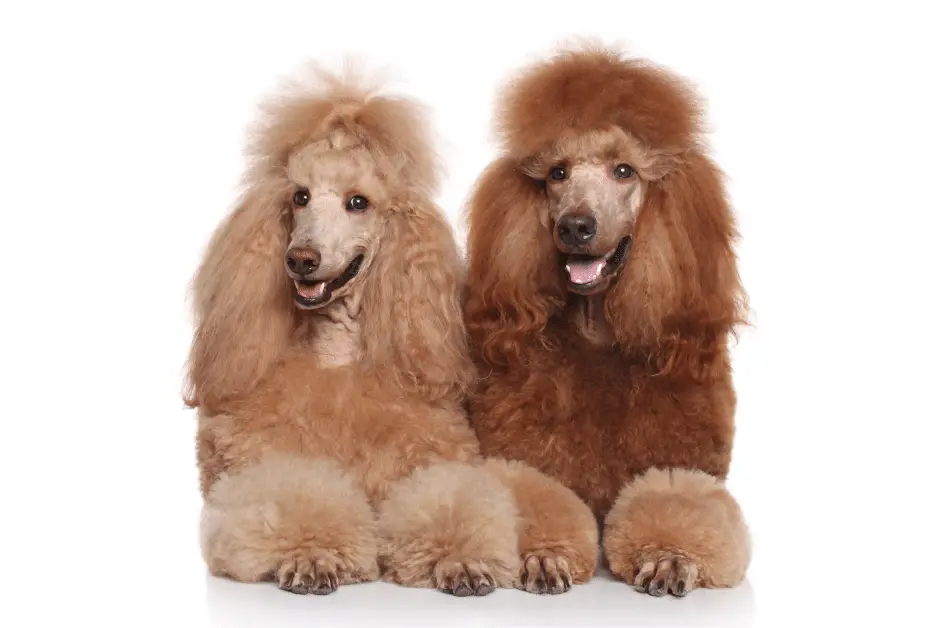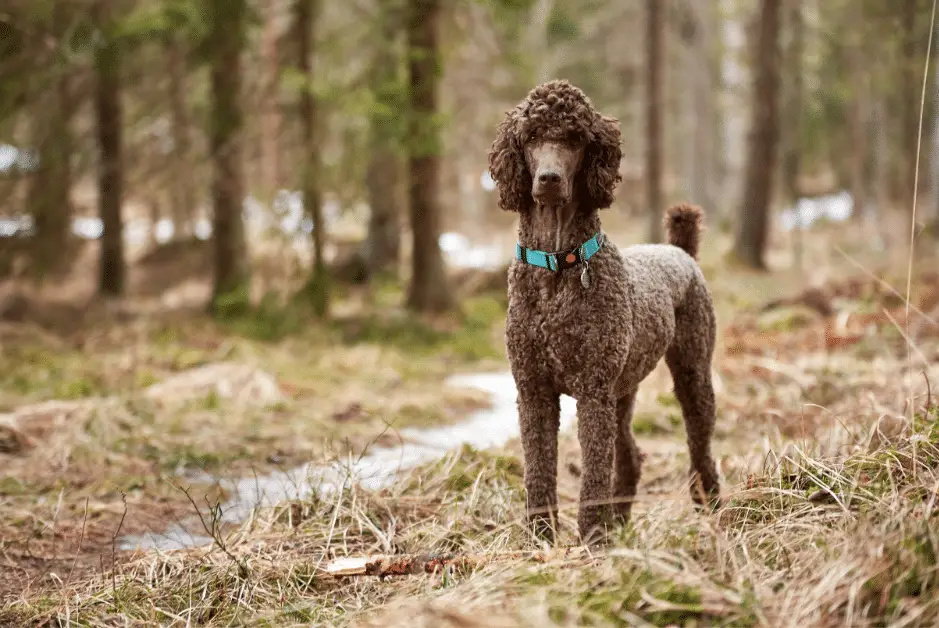Brown poodles distinctively display a warm, medium brown coat from birth. Their coat color ranges from light to dark brown without ever appearing as dark as black. By maturity at age two, their color fully develops without noticeable lightening.

Two defining physical traits identify brown poodles – liver-colored noses and eyes matching shades from dark brown to reddish-brown. Skin pigmentation aligns with their lighter coat hue. Some brown poodles present darker brown ears or stripes, but breed standards do not penalize such variations.
Their coats demand intensive grooming including frequent combing, trimming and bathing. Color naturally fades over time due to genetic graying traits. Brown poodles share a common lineage with black poodles, possessing comparable intelligence levels that make them well-suited for advanced careers.

Read our Smart Poodles - Smart Tricks eBook for only $2.99
Dive into a treasure trove of engaging tricks and tips designed specifically for your poodle!
Genetically, brown poodles descend from black-colored ancestors carrying modifier genes that determine their chocolate hue. While this heritage endows brown poodles with desirable traits, it can also present health risks if not properly managed. For instance, some lines are predisposed to diseases like Addison’s disease and cancer.
Responsible breeders screen breeding stock for genetic issues and use only healthy dogs from long-lived lineages to minimize such risks to future puppies. Through conscientious selective breeding focused on temperament, health and appearance, brown poodles can be bred toward improved hardiness and longevity.
What Will You Learn? 👇
Grooming a Brown Poodle
Grooming brown poodles requires dedication due to their dense, non-shedding coats. Regular care is important to prevent matting and skin irritation.
- Haircut: Brown poodles suit styles like the lamb trim which leaves hair 1-2″ long all over. Use thinning shears to create an appearance of shorter hair. Trim hair similarly around joints to increase mobility. Scissor hair very short on feet, tails, ears and sanitary areas.
- Bathing: Bathe brown poodles every 3-4 weeks using a moisturizing shampoo to prevent color fading. Gently work shampoo from roots to tips and thoroughly rinse. Condition weekly to keep coats soft and detangled.
- Brushing: Daily brushing with a slicker brush and comb distributes natural oils down the strands. Check for tangles or mats, especially behind ears and armpits. De-mat carefully to avoid pulling.
- Nail trims: Dremel or clip nails every 1-2 months to maintain a comfortable length for walking. File down any sharp edges.
- Teeth cleaning: Brush teeth 2-3 times per week to remove plaque and prevent gum disease. Start young for lifelong clean habits.
- Hair drying: Use a high-velocity dryer and pin brush technique to blow out coats straight after every bath. This maintains a tidy appearance between grooms.
With consistent home care, brown poodles can flaunt their coats’ beauty and owners can bond through quality grooming time. Regular professional grooms also ensure coats stay in top shape.
Temperament
A common misconception among some poodle owners is that certain coat colors correlate with higher intelligence. While black and white were historically preferred show colors, scientific studies have found no evidence that poodle intelligence differs according to hue.

Experts agree that breed standards originally emphasized black and white coats for visibility during performances, not because intelligence was selectively bred for those colors alone. All poodle colors descend from the same genetic heritage and share equivalent cognitive abilities.
Of course, as with humans, individual poodles will naturally vary in disposition and aptitude regardless of appearance. Champions and therapy dogs exemplify the full spectrum of poodle talent across every color.
How to care for aging brown poodles?
Here are some tips for caring for aging brown poodles:
- Adjust grooming frequency to every 6-8 weeks as older coats require less maintenance. Use hydrating shampoos to prevent drying.
- Monitor for graying/fading and supplement their diet with salmon oil, vitamins C & E to support skin and coat health. Apply leave-in conditioner between baths.
- Senior poodles are prone to dental disease so brush teeth daily. Give dental chews or rinses to reduce tartar buildup.
- Arthritis can impact mobility. Trim nails often, consider joint supplements, and don’t over-exercise aging legs.
- Limit sun exposure to protect fading coats and watch for skin cancers. Reapply sunscreen if outdoors long.
- Senior poodles need hydration so provide fresh water and senior formulated food. Address any thyroid, kidney or digestive issues promptly.
- Brush coats daily with a steel comb to distribute natural oils down strands. Check for mats behind ears and hind legs.
- Consider coat dye to cover gray if fading bothers the owner, but don’t use on skin as older dogs can absorb more dye.
Prioritizing coat care, dental hygiene and veterinary checkups helps brown poodles stay in their golden years. Adjusting routines supports their comfort and quality of life.
Health & Nutrition for Brown Poodles
Like all dogs, brown poodles require certain dietary nutrients to support their overall health and well-being. As purebred canines descended from established bloodlines, they may also inherit preset disease tendencies that owners should be aware of through responsible breeding practices.
- Nutrition: A high-quality dog food formulated for toys/minis/standards that lists meat as the #1 ingredient supports brown poodles’ need for protein. Omega fatty acids from salmon oil support skin and coat health. Senior dogs over 7 years need food with added glucosamine for joint support.
- Common Issues: As with black poodles, some lines are predisposed to Addison’s disease, an adrenal condition. Dilute brown dogs also face higher melanomas risks than solids. Regular vet checks monitor health. Good breeding mitigates conditions while fulfilling breed standards.
- Dental: Poodles prone to periodontal disease benefit from teeth brushing 2-3x weekly and dental treats/chews. Tartar buildup leads to infection and premature tooth loss.
- Coat: Supplements with biotin, vitamins C & E nourish coats prone to fading. Salmon oils protect against drying as guard hairs thin with age.
- Exercise: Daily play meets brown poodles’ needs for mental stimulation and 30-60 minutes exercise. Too little activity risks obesity while overexerting young/senior dogs endangers joints.
How are they bread?
These poodles are genetically close to black ones. Unfortunately, however, most of these poodles carry genes that cause color variation and brighten with age.
Nowadays, all breeders try to breed bleached versions with dark ones. This tendency is unlikely to improve the light color. On the contrary, it causes irreparable damage to a good color due to its clogging with lightning alleles. From the perspective of genetics, the breeding of dark and light poodles should be carried out completely separately, and this is the only way to keep good brown dogs clean.
Often these poodles are bred with black ones to improve coat quality and stabilize brown coloration. Of course, this method can help improve the brown color. However, it should be remembered that it requires a careful calculation of the options for further crosses at least three to four generations ahead. Many foreign authors recommend breeding black poodles with brown ones only in one generation.
Are brown poodles rare?
Once uncommon, brown has emerged as a standard poodle coat color. In the late 19th century, poodles served primarily as gundogs to retrieve waterfowl from lakes and streams. Dark colors like black blended best for stealthy work, while brown stood out against backgrounds.
By the 20th century, poodles shifted toward companion roles and the show ring. Black and white dominated as preferred “fancier” hues until color preferences broadened in the mid-1900s. Today’s trends embrace brown as a classic solid shade along with other colors.
While still outnumbered by blacks in many breeder litters, brown poodles appear more frequently in dog shows and advertisements. Their eye-catching good looks appeal to owners seeking uniqueness from prevalent poodle shades. Rescue groups also report brown poodles and mixes acquire homes faster than sable or parti varieties.
All poodle colors possess identical intelligence, trainability and temperaments. Choice often comes down to personal taste rather than any working advantage. With sustained popularity, brown poodles remain a standard attractive option for active families.

Are brown poodles expensive?
The cost of a brown poodle depends only on its size, not color rarity. Standard brown poodles cost $700-1500. Toy and miniature brown poodles cost $1000-2000, making them slightly higher priced. A breeder should never charge more for a puppy due to color. Size alone affects price for all poodles.
Why does a brown poodle turn gray and fade?
Brown poodles have a gene called G locus – “progressive graying”. If brown dogs have a mutation in this gene, they will gradually fade in color as they grow.
Of course, not all brown poodles have this mutation, but still, it is best to be informed. Given that this is a dominant mutation, if either parent was “progressively graying”, there is a 50% chance that the puppies also have the mutation. At 2–3 months of age, you will notice a color change, which usually ends by the time the dog is fully mature. However, some brown poodles may have only a few small changes during their life.
Share Your Experiences with Brown Poodles
Do you have any stories or insight to share about living with brown poodles? Their unique personalities, habits, or any health trends you’ve observed? Please feel free to add your experiences in the comments below.
Firsthand accounts from fellow brown poodle guardians provide valuable real-world context beyond generic breed info. Case studies on how certain diets or supplements positively impacted a dog’s coat or resolved dental issues also enlighten readers. And funny anecdotes about a poodle’s quirks always give us a smile!
We aim to cultivate an engaged community where owners help each other care for these charming companions. Your contributions based on personal experience with brown poodles further enrich this resource. Please leave a comment to join the discussion.
Marko is the founder and author at PoodleHQ, where he blends profound expertise with formal training in Animal Behavior and Canine Genetics. With multiple generations of poodles under his care, he’s a breed connoisseur, honored with the Canine Care Excellence Award and lauded by the International Pet Enthusiasts Association.


cute pictures!